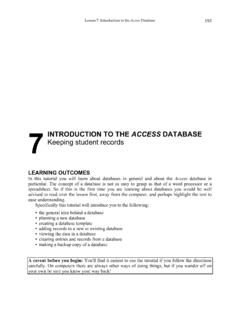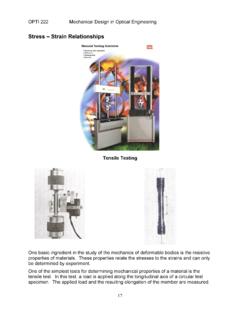Transcription of Mechanics of Materials - University of Pittsburgh
1 Department of Mechanical EngineeringStatics and Mechanics of MaterialsStress, Strain and Deformation: Axial LoadingChapter 4 Department of Mechanical EngineeringObjectives: Learn and understand the concepts of internal forces, stresses, and strains Learn and understand the key concept of constitutive relationship of linear Materials Know how to compute normal and shearing strains and stresses in mechanically and/or thermally loaded members (axial loading) Know how to compute strains and stresses of members belonging to indeterminate structuresDepartment of Mechanical EngineeringStress & Strain: Axial Loading Suitability of a structure or machine may depend on the deformations in the structure as well as the stresses induced under loading. Statics analyses alone are not sufficient. Considering structures as deformable allows determination of member forces and reactions which are statically indeterminate. Determination of the stress distribution within a member also requires consideration of deformations in the member.
2 This chapter is concerned with deformation of a structural member under axial loading. Department of Mechanical EngineeringShearing Stress Forces P and P are applied transversely to the member ave The corresponding average shear stress is, The resultant of the internal shear force distribution is defined as the shear of the section and is equal to the load P. Corresponding internal forces act in the plane of section C and are called shearing forces. Shear stress distribution varies from zero at the member surfaces to maximum values that may be much larger than the average value. The shear stress distribution cannot be assumed to be of Mechanical EngineeringShearing Stress ExamplesAFAP ave Single ShearDouble ShearAFAP2ave Department of Mechanical EngineeringBearing Stress in Connections Bolts, rivets, and pins create stresses on the points of contact or bearing surfaces of the members they b Corresponding average force intensity is called the bearing stress, The resultant of the force distribution on the surface is equal and opposite to the force exerted on the of Mechanical engineering Pass a section through the member forming an angle with the normal plane.
3 Cossincossincoscoscos00200 APAPAVAPAPAF The average normal and shear stresses on the oblique plane areStress on an Oblique Plane sincosPVPF Resolve P into components normal and tangential to the oblique section, From equilibrium conditions, the distributed forces (stresses) on the plane must be equivalent to the force of Mechanical engineering The maximum normal stress occurs when the reference plane is perpendicular to the member axis,00m AP The maximum shear stress occurs for a plane at + 45o with respect to the axis, 00245cos45sinAPAPmMaximum Stresses cossincos020 APAP Normal and shearing stresses on an oblique planeDepartment of Mechanical EngineeringChapter Displacement, Deformation, and StrainDepartment of Mechanical EngineeringDisplacement, deformation, and strain Displacement A vector that represents a movement of a point in a body (due to applied loads) with respect to some reference system of axes Translation and/or rotation Shape and size of the body do not change Deformation A vector that represents a movement of a point in a body (due to applied loads) relative to another body point The shape and size of the body change (being deformed) Volume may be unchanged (special cases) Strain Intensity of deformation Objects of the same Materials but different sizes demonstrate different effects when subjected to the same load Normal strain ( ): measures the change in size (elongation/contraction) Shearing strain ( ): measures the change in shape (angle formed by the sides of a body)Department of Mechanical EngineeringNormal Strainstrain normalstress LAP LAPAP 22 LLAP 22 Department of Mechanical EngineeringNormal and shearing strains Normal strain.
4 Average axial strain assumed that the deformation is homogeneous Average value along the axial direction Shearing strain = the angle in the deformed state between the two initially orthogonal reference lines True axial strain The true local strain at a point in the body Units of strain dimensionless Tensile strain == positive, compressive strain == negative Lnavg '2tan LsavgdLdPn )(Department of Mechanical EngineeringExample Problem 4-8 Given BC , compute the elongation of the central portion of the bar Given total determine the axial strain in the end portions of the bar (basically E )2 1 8 FFABCDD epartment of Mechanical EngineeringExample Problem 4-9 = 1000 m/m = 10-3 Determine the displacement of A ( A ) Department of Mechanical EngineeringExample Where is the shearing strain?Fixed supportDoes not move a bit!!Department of Mechanical EngineeringExample Determine the shearing strain at P'2tan Lsavg Department of Mechanical EngineeringExample Normal strain along a diameter = the ratio of the net diameter change to the original diameter Circumferential strain = the ratio of the net circumference change to that of the original circumferentialFFexpandsDepartment of Mechanical EngineeringFFDepartment of Mechanical Engineering4-5 Stress-strain-temperature relationships (constitutive relationship) Stress vs.
5 Strain Thermal strain Deformation of axially loaded membersDepartment of Mechanical EngineeringStress vs. strain relationship Structural analysis and design requires understanding of the system of the applied forces and the material behavior The behavior of a material can be studied by means of mechanical testing Stress vs. strain diagrams are often used to describe the material behavior Stress vs. strain diagrams are supposedly/theoretically identical for the same material , but technically there is always some differences Department of Mechanical EngineeringWhy stress vs. strain? Force vs. deformation and stress vs. deformation diagrams cannot uniquely describe the material behavior Force depends on the application area Displacement depends on the length of the specimensDepartment of Mechanical EngineeringWhy stress vs. strain? When the stress vs. strain diagrams are used, the curves are merging diminishing the effects of size of the samplesDepartment of Mechanical EngineeringThe tensile test Uniaxial loading tester allows us to study the behavior of Materials under tension The applied force is measured by means of load cells The stress is calculated utilizing the cross section area of the sample The deformation can be measured from the motion of the grips where the sample is attached to Utilizing the original length, the strain can be calculated Alternatively, a strain gauge may be used The stress vs.
6 Strain diagram can be obtainedDepartment of Mechanical EngineeringThe Tensile Test (Normal Stress-Normal Strain)Department of Mechanical EngineeringStress-Strain Diagram: Ductile MaterialsDepartment of Mechanical EngineeringStress-Strain Diagram: Brittle MaterialsDepartment of Mechanical EngineeringTypical stress vs. strain diagramsDepartment of Mechanical EngineeringElastic vs. Plastic behavior If the strain disappears when the stress is removed, the material is said to behave elastically. When the strain does not return to zero after the stress is removed, the material is said to behave plastically. The largest stress for which this occurs is called the elastic of Mechanical EngineeringModulus Modulus are used to quantify the strength of a material Young s modulus = elastic modulus (E) The slope of the linear portion of the curve A = proportional limit Tangential modulus (Et ) The slope of the stress vs.
7 Strain curve at any selected strain Secant modulus (Es ) The slope of the line connecting the origin to any point on the stress vs. strain curve (practically, beyond the proportional limit)Department of Mechanical EngineeringSpecial points on the curve A = proportional limit D = elastic limit Beyond this point, the material is no longer elastic B= Yield point (in fig. a) A stress level beyond which the material would demonstrate high strain for a small stress (perform like a plastic) B= Yield strength (point B in fig. b) Stress that will induce permanent set (an offset to the original length) In fig. b, line OC = the offset, line BC is parallel to OA Ultimate strength (see in fig. a) The maximum engineering stress before rupture Different from the true stress due to necking Department of Mechanical EngineeringLinearly Elastic region Elastic: Strain is gone when the load is gone Stress vs. strain is linear E = Young s modulus (elastic modulus, modulus of elasticity) can be used The Hooke s law The most primitive stress vs.
8 Strain relationship The Hooke s law is valid only in the elastic region For shearing, use G = modulus of rigidity or shear modulus E G Department of Mechanical EngineeringPoisson s ratio A constant stated in 1811 by Sim on D. Poisson A material loaded in one direction will undergo strains perpendicular to the direction of the load in addition to those parallel to the load The ratio between the two strains = Poisson s ratio ( ) lat = lateral strain = t = tranverse strain long = longitudinal strain = a = axial strain The sign of strain is positive when the strain is outward Relates the G to Eatlonglat GE 12 Department of Mechanical EngineeringPoisson s Ratio For a slender bar subjected to axial loading:0 zyxxE The elongation in the x-direction is accompanied by a contraction in the other directions. Assuming that the material is isotropic (no directional dependence),0 zy Poisson s ratio is defined asxzxy strain axialstrain lateral GE 12 E, G, and related byDepartment of Mechanical EngineeringNonlinear behaviors Nonlinear elastic Elastic but not linear Rubbers Bio soft tissues Elastoplastic: Nonlinear but bi-linear Easy to formulate Ductile Able to sustain plastic deformation (high strain but low stress) Gradual stages prior to rupture safe Steels, Plastic Brittle The opposite of ductile No gradual stages before rupture Concrete, Alloys, Bones, cold steel Strain hardening or strain stiffening Strain softeningDuctile materialBrittle materialDepartment of Mechanical EngineeringEffect of composition Example.
9 High alloy content causes the steel to become ductile Low alloy contentHigh alloy contentSoft, ductileStrong, brittleDepartment of Mechanical EngineeringEffects of temperature High temperature causes the material to become ductile Department of Mechanical EngineeringEffects of loading direction For ductile Materials , tension and compression behaviors are assumed to be the same For brittle Materials , they are different Department of Mechanical EngineeringExample Given: stress vs. strain diagram (beware of the lower and upper scales) Initially the dia = Determine: Yield strength at offset ( strain) Tangent modulus at 60 ksi (Et ) Secant modulus at 70 ksi (Es ) The true stress at 70 ksi if the diameter of the specimen was EsMust find the loading PDepartment of Mechanical EngineeringThermal strain When unrestrained, most engineering Materials expand when heated and contract when cooled Coefficient of thermal expansion (CTE) = thermal strain due to a one degree (1o) change in temperature is a material property (and it may depend on T) Thermal strain Total strain Please follow example problems 4-11 and 4-12 TT TET Department of Mechanical EngineeringDeformation of axially loaded members (linear Materials )
10 Uniform member single loadEAPLELL E = Modulus of elasticityA = cross sectional areaP = tension/compression forceL = undeformed length = normal strain = normal stressL E AP Constitutive relationDefinition of strainDefinition of stressDepartment of Mechanical EngineeringDeformation of axially loaded members Multiple loads/sizes niniiiiiiAELP11 Department of Mechanical EngineeringExample Always assume that the internal force is in tension 1st find the internal force; PA , PB , and PC from FBDs Determine the displacement of each member or use the total displacement formulation Department of Mechanical EngineeringExample: Given: A is a tube B is a solid cylinder Determine the total deflectionBA Department of Mechanical EngineeringExample ProblemDetermine the deformation of the steel rod shown under the given in. dDESOLUTION: Divide the rod into components at the load application points. Apply a free-body analysis on each component to determine the internal force Evaluate the total of the component of Mechanical EngineeringSOLUTION: Divide the rod into three components:22121in 12 AALL233in 16 AL Apply free-body analysis to each component to determine internal forces,lb1030lb1015lb1060333231 PPP Evaluate total deflection, ALPALPALPEEALP iiiii Department of Mechanical EngineeringThermal Strains and Stresses A temperature change results in a change in length or thermal strain.











